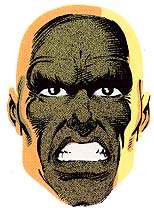Master Order
| Master Order | |
|---|---|
 Master Order as depicted in Marvel Two-in-One Annual #2 (1977). Art by Jim Starlin. | |
| Publication information | |
| Publisher | Marvel Comics |
| First appearance | Marvel Two-in-One Annual #2 (1977) |
| Created by | Jim Starlin |
| In-story information | |
| Species | Cosmic entity |
| Abilities |
|
Master Order is a character appearing in American comic books published by Marvel Comics. Created by Jim Starlin, the character first appeared in Marvel Two-In-One Annual #2 (1977).[1] Master Order is an abstract entity.[2][3] It is the cosmic counterpart of Lord Chaos and serves as the embodiment of order.[4][5]
Publication history
[edit]This section needs expansion. You can help by adding to it. (June 2014) |
The character debuted in Marvel Two-In-One Annual #2 (1977), created by Jim Starlin.[6] It appeared in the 2016 Ultimates 2 series.[7]
Fictional character biography
[edit]Master Order embodies order and balance in the universe and is the opposing force to "brother" entity Lord Chaos.[8] The pair are rarely seen, but appear to manipulate events to prompt Spider-Man to solicit the Thing to join the Avengers and Warlock in the first war against the Titan Thanos and defeat him.[9] Master Order and Lord Chaos were then seen observing King of the Norse Gods Odin and master villain Dormammu play a cosmic game of chess.[10] Master Order and Lord Chaos next conspired with other metaphysical and "omnipotent" beings against the Beyonder.[11] Lord Chaos and Master Order were then summoned by the Silver Surfer to regain control over their servant the In-Betweener.[12] They imprisoned the In-Betweener for his transgressions.[13] Master Order and Lord Chaos also attend the funeral of Eon and speak with cosmic hero Quasar.[14]
Master Order and Lord Chaos participated in the congress of metaphysical and abstract beings to determine Thanos' fitness to wield the Infinity Gauntlet. They choose to join Adam Warlock and the other cosmic deities in a bid to stop Thanos.[15] With the other abstract beings, they battled Thanos,[16] and then battled Nebula when she obtained the Gauntlet from Thanos.[17] The congress of abstract beings then witnessed Adam Warlock's cosmic trial to determine his worthiness to wield the Infinity Gauntlet.[18] Lord Chaos and Master Order were next seen among a group of abstract beings questioning the Beyonder from the Dimension of Manifestations.[19]
During the Time Runs Out storyline, the Beyonders kill Chaos, Order, the In-Betweener, and other abstract entities across the multiverse.[20]
Following the restoration of the universe in Secret Wars, Chaos and Order become disgruntled by Galactus' evolution from a force of destruction to a force of creation. They kill the Living Tribunal and force the In-Betweener to fuse them into Logos, a new being who can take his place. However, they are eventually separated by Black Panther's astral form.[21][22]
Powers and abilities
[edit]Master Order is an abstract being who embodies the metaphysical concept of Order; as such it has no physical form, although on occasion it has manifested as an image of a disembodied bald male head. It has the ability to control and manipulate time, reality, and space.[23]
It has been implied that Master Order, and its counterpart, Lord Chaos, have vast powers which they use to manipulate events within their sphere of influence in subtle ways.[volume & issue needed] It is known that, through some as yet unknown process, Master Order and Lord Chaos worked together to create the metaphysical being known as the In-Betweener.[volume & issue needed]
Thanos wielding the Infinity Gauntlet ranked Master Order's scale of power as above Galactus, but below Eternity.[24]
However, later he and Lord Chaos were able to easily kill the Living Tribunal by blasting him with energy, and also defeat Lifebringer Galactus after transforming into Logos.[25]
Other versions
[edit]Master Order and Lord Chaos battle Thanos once more in an alternate universe when he possesses the Heart of the Universe.[26]
References
[edit]- ^ Barnhardt, Adam (October 31, 2018). "Who Could Be the Greater Threat Than Thanos in 'Avengers 4?'". ComicBook.com. Retrieved September 1, 2023.
- ^ Roberson, Chris Chan (August 12, 2022). "15 Marvel Characters Who Could Defeat The Celestials". Comic Book Resources. Retrieved September 1, 2023.
- ^ Brayson, Johnny (September 30, 2022). "The 50 Most Powerful Characters In The Marvel Universe, Ranked". Bustle. Retrieved September 1, 2023.
- ^ Stevens, Tim (December 29, 2016). "A Brief History of Order and Chaos". Marvel.com. Retrieved September 1, 2023.
- ^ Dunphey, Charles (July 8, 2020). "Ranking The 19 Most Powerful Marvel Cosmic Characters". Comic Book Resources. Retrieved September 1, 2023.
- ^ Cacciatore, Francesco (August 20, 2022). "Spider-Man Has Three Different Origins, & They're All Canon". Screen Rant. Retrieved September 1, 2023.
- ^ Lovett, Jamie (December 27, 2016). "Marvel Kills One Of Its Most Powerful Characters". ComicBook.com. Retrieved September 1, 2023.
- ^ Iacobucci, Jordan (July 16, 2022). "Eternity And 9 Other Crucial Cosmic Entities In Marvel Comics". Screen Rant. Retrieved September 1, 2023.
- ^ Marvel Two-in-One Annual #2 (1977)
- ^ Thor Annual #9 (1981)
- ^ Secret Wars II #6
- ^ Silver Surfer vol. 3, #17 (Nov. 1988)
- ^ Silver Surfer vol. 3, #18 (Dec. 1988)
- ^ Quasar #26 (Sep. 1991)
- ^ Infinity Gauntlet #3 (Sep. 1991)
- ^ Infinity Gauntlet #4 - 5 (Oct. - Nov. 1991)
- ^ Infinity Gauntlet #6 (Dec. 1991)
- ^ Warlock and The Infinity Watch #1 (Feb. 1991)
- ^ Quasar #38 (Sep. 1992)
- ^ New Avengers vol. 3 #30 (April 2015)
- ^ Ultimates 2 (Vol 2) #2
- ^ Ultimates 2 (Vol 2) #3
- ^ Karbank, Octavio (November 16, 2017). "15 Evil Marvel Gods Too Frightening For The MCU". Comic Book Resources. Retrieved September 1, 2023.
- ^ Thanos Annual #1 (2014)
- ^ Ultimates 2 #2
- ^ Marvel: The End #1 - 6 (2003)
External links
[edit]- Master Order at Marvel.com
